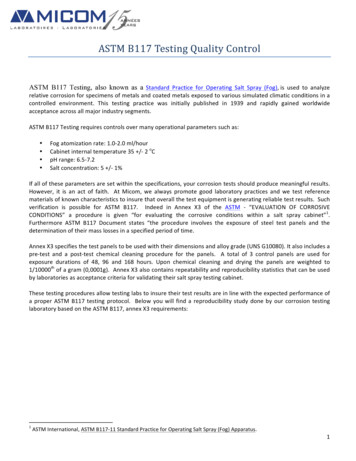
Transcription
DESIGN, TESTING, AND OPERATING EXPERIENCE OF A SALTWATER DISPOSALSYSTEM OIL-WATER SEPARATORKirby S. Mohr, P.E.Mohr Separations Research, Inc.Lewisville, TXGary MarkhamDragon ProductsBeaumont, TXLarry KirklandConsultantMidland, TXTimothy Agatep, EITMohr Separations Research, Inc.Lewisville, TXAbstract:Environmental regulation of oil in salt water disposal from oil and gas operations arebecoming more stringent and the high value of crude oil makes recovery of any residualoil in the produced water attractive. Most of the current methods used for recovery areolder designs and not very efficient, so a new and more efficient system would be useful inthe industry.A test was performed using a coalescing media test system at a disposal well site in WestTexas and the oil removal efficiency was very good - enough to suggest the commercialvalue of a large separation system. A full size system was designed and constructed usinga frac tank as the basic structure and utilized coalescing media to perform the separation.The following paper will include information on the initial testing, design of the system, andfield operations and performance.Keywords:Oil, water, crude. oil-water separator, separation, saltwater disposal
DESIGN, TESTING, AND OPERATING EXPERIENCE OF A SALTWATER DISPOSALSYSTEM OIL-WATER SEPARATORKirby S. Mohr, P.E.Mohr Separations Research, Inc.Lewisville, TXGary MarkhamDragon ProductsBeaumont, TXLarry KirklandConsultantMidland, TXTimothy Agatep, EITMohr Separations Research, Inc.Lewisville, TXIntroduction:Many separation devices currently used in the oil production industry are similar oridentical to those used a hundred years ago. The technology that was adequate forproduction at that time is no longer adequate, either for environmental purposes or torecover the last amount of oil present, in produced water that is to be injected through asaltwater disposal system. Many types of separation equipment, including horizontalseparators and gunbarrels, are capable of removing most of the oil from the saltwater, butare not efficient at removing the last traces of oil.The residual oil in the water downstream of the old-style separators can be as much as1% to 3%. This amount of oil, while not representing the bulk of the production, can still beof substantial value.Because of this interest in removing virtually all of the oil, Mohr Separations Research,Inc. (MSR) was contacted by a consultant for a major West Texas production companyabout a more efficient separator design.The customer wanted to improve separation for:1.Resource recovery – they can sell any oil that is captured by the system2.Avoiding primary plugging of downhole areas by oil3.Avoiding secondary plugging of downhole areas by bacterial growthThis oil, which is present in the saltwater, will also cause problems in the disposal well if itis allowed to be pumped down the well. The problems which can be caused are primarily
plugging problems, firstly because of the oil itself, and secondly because of bacterialgrowth, which can happen at the underground injection point.It was therefore desired to have a more efficient design which would remove virtually all ofthe oil from the water, firstly, for profitability, and secondly, for avoiding plugging andsubsequent maintenance problems downhole.In the customer’s West Texas and New Mexico facilities, they had substantial amounts oflight crude oil with a specific gravity of approximately 0.82, contained in a large amount ofwater, up to 36,000 barrels per day (1050 US GPM). They also had a warm watertemperature of about 100 F.Origin of the Water:Common separations systems used in the oilfield include gunbarrel separators andhorizontal separators. The gunbarrel separator systems, as illustrated in Figure 1 below,are simple gravity systems, where the oil, gas and water mixture comes to a preseparation system and the gas is supposed to mostly separate out in the pre-separationsystem and join the gas, which eventually separates out of the oil-water mixture at the topof the gunbarrel. The oil and water mixture flows into the distributor, near the bottom of theseparator, where the oil droplets are supposed to collect under the umbrella styledistributor and weep upward into the oil layer, and water droplets are supposed tocoalesce and come downward. Any water drops entrained in the rising oil will migrate intothe oil layer above the water layer, and from there, must fall back down through the oillayer to rejoin the water.These systems are simple, easy to operate, and tolerant of solids, but the flow pattern andlack of properly designed internals keeps them from being very efficient at removingsmaller droplet sizes. This is because the design of the gunbarrel does not meet thelaminar flow criteria for Stokes’ law, which is further discussed below.Figure 1: Typical Gunbarrel Separator
Another common separator design, often used in the oilfield, is a three-phase horizontalseparator, as illustrated in Figure 2 below. In this system, the oil and water and gasmixture enters through the inlet nozzle, near the top, and the gas immediately disengages,prior to the inlet deflector, and proceeds along the top of the separator to the oppositeend, where there may or may not be a separate gas outlet. The gas may also becombined with the liquid in the outlet. As shown in the figure, a water layer is maintainedbelow the oil layer.Figure 2: Typical Three-Phase Horizontal SeparatorProblems associated with this design are that all of the water in the inlet must passthrough the oil layer in order to get to the water layer at the bottom of the separator. Thiscauses entrained oil droplets to be carried downward into the water layer; likewise, thereshould be a movement of entrained water drops through the oil layer, down to the waterlayer. Neither of these actions happens very efficiently because the systems do not meetthe requirements for Stokes’ law and because they are designed so that the droplets ofone phase must pass through another phase.Separation by Gravity (Stokes’ Law):In 1845, an English mathematician named George Stokes first described the physicalrelationship that governs the settling solid particles in a liquid (Stokes Law, 1845). Thissame relationship also governs the rising of light liquid droplets within a different, heavierliquid. This function, simply stated, is (Perry, 1963):Where:
Vp particle rising or settling velocity, cm/secG gravitational constant, 980 cm/sec2µ absolute viscosity of continuous fluid, poisedp density of particle (or droplet), gm/cm2dc density of continuous fluid, gm/cm2D diameter of particle, cm.A negative velocity is referred to as the particle (or droplet) rise velocity. AssumptionsStokes made in this calculation include:1) Particles are spherical2) Particles are the same size3) Flow is laminar, both horizontally and vertically. Laminar flow in this context meansflowing gently, smoothly, and without turbulence.From the above, it can be seen that the variables are the density of the droplets, theviscosity of the continuous phase (temperature), specific gravity difference between thecontinuous liquid and the particle, and the average droplet size (square function).The rise rate of oil droplets is also governed by Stokes' Law. If the droplet size, specificgravity, and viscosity of the continuous liquid are known, the rise rate can be calculated.To calculate the size of an empty vessel gravity separator, it is first necessary to calculate,by the use of Stokes' Law, the rise velocity of the oil droplets. The size of the separator isthen calculated by considering the path of a droplet entering at the bottom of one end ofthe separator and exiting from the other end of the separator. Sufficient volume (residencetime) must be provided in the separator so that an oil droplet entering the separator, at thebottom of the inlet end of the separator, has time to rise to the surface before the watercarrying the droplet exits the opposite end of the separator.Figure 3: Rise Path of a Typical Droplet
Calculation of the rise rate by this method is a gross simplification of actual field conditionsbecause oil droplets are not all the same size, and they tend to coalesce into largerdroplets. Furthermore, inevitable turbulence within a separator makes an orderly rise ofvery small droplets impossible.Droplets will rise, following Stokes' Law, as long as laminar flow conditions prevail. Whenthe particle size exceeds that which causes a rise rate greater than the velocity of laminarflow, flow around them (as they rise) begins to be turbulent. Particles of this size andlarger do not rise as rapidly as would be expected from calculations based on Stokes' Lawbecause of the hydrodynamic drag. However, they do rise very quickly in relationship tosmaller droplets, and so, are removed by a properly designed separator.Very small particles, such as those of 8 microns (micrometers) and less in diameter, donot rise according to Stokes’ Law (or hardly at all) because the random motion of themolecules of the water is sufficient to overcome the force of gravity. As a result, they movein random directions. This random motion is known as Brownian Motion. Fortunately, thevolume of a droplet decreases according to the cube of the diameter, so these very smalldroplets tend to contain very little oil by volume, and unless there are large, largequantities of very small droplets (such as would be created by using a centrifugal pump topump the water), they contain negligible amounts of oil.When the droplets coalesce, they do not form flocs as the solid particles can, but coalesceinto larger droplets. Interfacial tension (sometimes referred to as surface tension) of theliquid tends to make the droplets assume spherical shapes, since this is the smallestpossible shape for a given mass. This is convenient for a separator designer because it isrequired by Stokes’ Law.Initial Testing:MSR is a designer and manufacturer of coalescing plate separators for use in many oilremoval applications. The possible installation was reviewed to determine if it was a likelycandidate for the use of coalescing media, and the relatively low density crude oil to beremoved indicated it was likely that the application would work well using MSR’scoalescing plate technology. An initial flow test utilizing a small MSR-11 type separatorwas arranged.
Figure 4: MSR-11 Test UnitThe MSR-11 pilot testing unit was installed at a customer owned facility in eastern NewMexico. Flow was by gravity from the bottom of the large storage tank through thestainless steel separator and the outlet water was directed to a tote. This arrangementwas made so that testing could be done without disturbing operations of the plant. Thephoto below shows the separator mounted on a metal stand and the inlet hose may beseen from the tank, over the berm to the separator and the cleaned outlet water flow wasthen directed to the tote.Figure 5: Pilot Test Setup
Initial visual comparison between the inlet and outlet samples indicated good separation.In Figure 6 below, the inlet samples are in jars one and three from the left and thecorresponding outlet samples are in jars two and four from the left.Figure 6: Pilot Testing Typical SamplesThe pilot testing program was conducted in September 2013. The test flow rate variedsomewhat because of the test system design; average flow rate was approximately 1 USGPM. The separator operating temperature was approximately 100 F. Inlet sampleconcentrations varied from 77 mg/L to 128 mg/L, and the outlet concentrations varied from21 mg/L to 28 mg/L. These were lower concentrations than initially expected by thecustomer, and it is believed that this was at least partly due to the sample flow being takenfrom a location near the bottom of the tank. Because the water is from various sources, itis likely that some truckloads of water will contain substantially more oil than was foundduring this test.The average oil droplet size in the flow stream was back calculated based on theinformation provided by the test results. For the relatively low inlet oil concentrations usedin that test program, the average oil droplet size was found to be about 15 µ. There are ofcourse many larger droplets than 15 µ and some smaller ones. At higher concentrations,the average droplet size would be expected to be higher.
Full Scale Unit Design:Preliminary calculations and discussions with the customer indicated that a systeminstalled in a 500 barrel frac tank would be convenient for processing approximately36,000 barrels per day of water (1050 US GPM).This size tank lends itself to a coalescing system consisting of one or more rows of theMSR modules, seven modules wide and with a water height within the modules of 71.5inches.After deciding on the width and height of the coalescing system, MSR considered severalpossibilities with multiple rows of coalescing media. It was determined that the maximumamount of media that might possibly be required would be seven rows. The design of thesystem was therefore for any amount of media between one and seven rows. This designgives the flexibility of being able to use the same unit for substantially differentapplications by simply adding or subtracting media as required.The particular customer application that the initial unit was designed for conveniently fit ina system with three rows of media. The design of the initial unit that was constructed isshown in the sectional drawing shown in Figure 7 below.The initial unit was sized for an effluent quality of 50 mg/L or less with a 0.82 specificgravity West Texas crude oil and an effluent quality of 50 mg/L or less utilizing three rowsof media. Additional rows can be added, if necessary, for larger flows or lower effluents.Figure 7: Full-Scale Unit SectionBecause of the likelihood of some solids being present in the inlet, even though the bulksolids will have been removed upstream in other
the separator and exiting from the other end of the separator. Sufficient volume (residence time) must be provided in the separator so that an oil droplet entering the separator, at the bottom of the inlet end of the separator, has time to rise to the surface before the water carrying the droplet exits the opposite end of the separator. Figure 3: Rise Path of a Typical Droplet. Calculation of .











